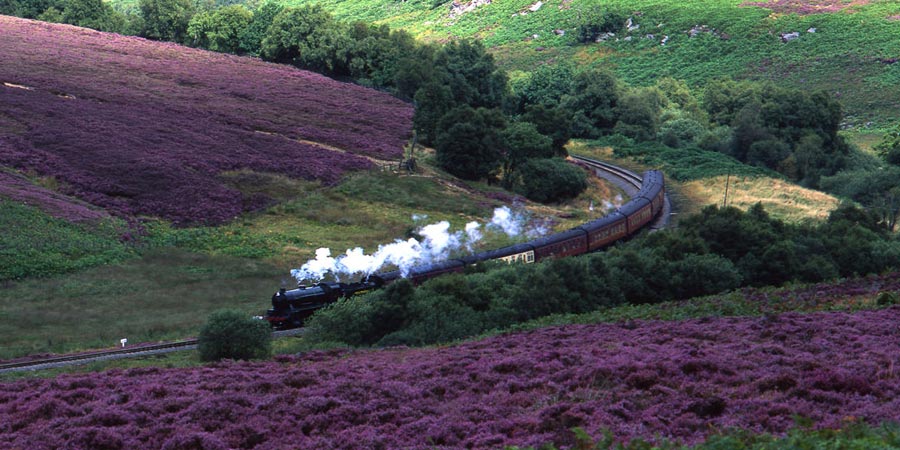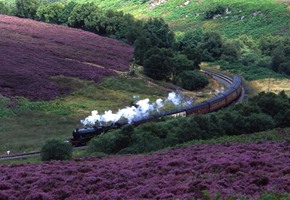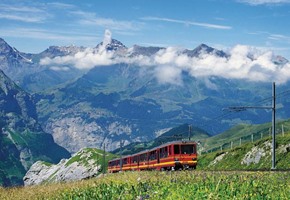From wild moorland and floral meadows to ever-dramatic coastlines, the very best of England's natural beauty is often framed by a train window. Step back in time and immerse yourself in a golden era of rail travel at its finest on one of these unmissable railways.
The North Yorkshire Moors Railway
One of England's longest heritage railways lines, the North Yorkshire Moors Railway winds its way through the cinematic North Yorkshire Moors National Park, packing a whole lot of spectacular scenery into its 18 miles.
Originally opened in 1836 to transport goods to and from the coast, the line was reopened as the North Yorkshire Moors Railway in the 1960s. Since then, it has cemented its reputation as one of the country's finest rail experiences, thanks to its carefully restored carriages, steam locomotives and sprawling views across 'God's Own Country'.
Travel on the North Yorkshire Moors Railway and you'll find yourself marvelling at dramatic heather moorland, trickling streams, storybook villages and landscapes virtually unchanged since the line was first opened. Highlights along the way include Goathland, famous as 'Aidensfield' in ITV's Heartbeat and 'Hogsmeade Station' in the Harry Potter movies, and the peaceful village of Grosmont, nestled in the lush Esk Valley. To top it all off, the terminus, Whitby, is a place you could happily while away an afternoon exploring, famous for its beaches, clifftop abbey and award-winning fish and chip restaurants.
The Settle to Carlisle Line
Some railways stand alone as a monument in their own right, and the Settle-Carlisle Line is one of them. A lasting testament to the skill and dedication of the Victorian railway engineers who built it in the late 1800s, the iconic railway is one of England's best-loved and most scenic lines.
From Settle, a quaint market town in North Yorkshire, you'll snake through some of the finest landscapes England has to offer on your way to the historic fortress city of Carlisle. A journey on the Settle-Carlisle Line offers up spectacular, ever-changing views as the train passes through the verdant scenery of the Yorkshire Dales, across the mighty Pennines and into the heart of the gorgeous countryside that characterises Cumbria.
A particularly scenic point on the journey comes as you cross the famed Ribblehead Viaduct, a dramatically beautiful limestone bridge that's the longest on the route. Opened in 1875 for the sole purpose of being used by the Settle-Carlisle Line, it carries the train high over the boggy marshland below and under the shadow of Whernside, the highest of the Yorkshire Three Peaks.
The North Norfolk Railway
The North Norfolk Railway's nickname gives passengers an insight into the beauty they'll discover on the route. 'The Poppy Line', as the railway is affectionately known, runs between the Victorian seaside town of Sheringham and the Georgian town of Holt, showcasing the best of Norfolk's spectacular coastal scenery.
The line was originally opened in June 1887 and reopened as a heritage route in 1976. Like many of England's most scenic railways, the reopening was thanks to a dedicated preservation society who formed after the closure, united in their belief that the charming scenery of the Norfolk Broads was best admired from the tracks.
The route is easily one of the most scenic around, particularly in summer months when the train winds past the multitude of gorgeous flowers that give 'The Poppy Line' its nickname. The name comes from poet Clement Scott, who explored this unspoilt part of the country by rail in 1883, referring to it as 'Poppy-land' in his poem 'The Garden of Sleep'. Still, no matter the season, it's a route to pay attention to, trundling past idyllic scenery of chocolate-box villages, vast open countryside, and pine woodlands.
"Neath the blue of the sky in the green of the corn,
It is there that the royal red poppies are born!
Brief days of desire, and long dreams of delight,
They are mine when my Poppy-land cometh in sight."






